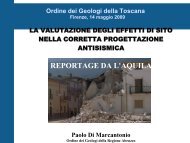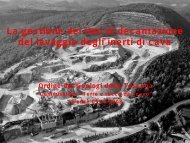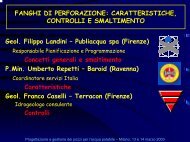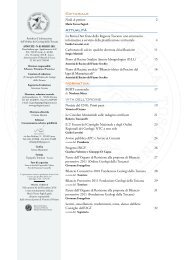le prove di emungimento - Ordine dei Geologi della Toscana
le prove di emungimento - Ordine dei Geologi della Toscana
le prove di emungimento - Ordine dei Geologi della Toscana
Create successful ePaper yourself
Turn your PDF publications into a flip-book with our unique Google optimized e-Paper software.
La portata <strong>di</strong> <strong>emungimento</strong> dovrà essere sufficientemente bassa da evitare grosse per<strong>di</strong>te <strong>di</strong><br />
carico, soprattutto se il pozzo capta un acquifero libero; in quest’ultimo caso è consigliabi<strong>le</strong> che<br />
l’abbassamento non sia superiore a 0,15 volte lo spessore saturo <strong>di</strong> acquifero.<br />
Se il pozzo è <strong>di</strong> grande <strong>di</strong>ametro la prova deve svolgersi per un tempo sufficiente a superare<br />
l’effetto capacitivo (ve<strong>di</strong> paragrafo specifico).<br />
BIBLIOGRAFIA<br />
Bouwer H., Rice C. (1976). A slug test for determining hydraulic conductivity for unconfined<br />
aquifers with comp<strong>le</strong>tely or partially penetrating wells, Water Resources Research, vol. 12, n. 3,<br />
pagg. 423-438.<br />
Bouwer H. (1989), The Bouwer and Rice slug test. An update, Groundwater, vol. 27, n. 3, pagg.<br />
304-309.<br />
But<strong>le</strong>r Jr. JJ. (1998). The design, performance and analysis of slug tests, Lewis Publishers, Boca<br />
Raton, FL.<br />
Chenaf D. & Chapuis R.P. (2002). Methods to determine storativity of infinite confined aquifers<br />
from a recovery test. Groundwater, 40, 4, 385-389.<br />
Di Molfetta A. (1995). Determinazione del<strong>le</strong> caratteristiche idro<strong>di</strong>namiche degli acquiferi e<br />
produttive <strong>dei</strong> pozzi me<strong>di</strong>ante <strong>prove</strong> <strong>di</strong> pompaggio, IGEA, n. 4, pagg. 13-30.<br />
Domenico P.A. & Schwartz F.W. (1997). Physical and Chemical Hydrogeology. II e<strong>di</strong>tion, John<br />
Wi<strong>le</strong>y & Sons.<br />
Fetter C. W. (1994). Applied Hydrogeology. Prentice Hall.<br />
Genetier B. (1993). La pratica del<strong>le</strong> <strong>prove</strong> <strong>di</strong> pompaggio in idrogeologia, Dario Flaccovio Ed.,<br />
Pa<strong>le</strong>rmo.<br />
Halford K.J., Weight W.D., Schreiber R.P. (2006). Interpretation of transmissivity estimates from<br />
sing<strong>le</strong>-well pumping aquifer tests., Groundwater, 44, 3, 467-471.<br />
Helweg O. J. (1994). A general solution to the step-drawdown test. Groundwater, 32, 3, 363-366.<br />
Kawecki M. W. (1995). Meaningful interpretation of step-drawdown tests. Groundwater, 33, 1, 23-<br />
32.<br />
Kruseman G.P., De Ridder N.A. (1989). Analysis and evaluation of pumping test data, IV ed., ILRI,<br />
Wageningen, The Netherlands.<br />
Zheng L., Guo J.Q. & Lei Y. (2005). An im<strong>prove</strong>d straight-line fitting method for analyzing<br />
pumping test recovery data. Groundwater, technical note, 43, 6, 939-942.<br />
32






